Port of Hong Kong
| Port of Hong Kong 香港港口 | |
|---|---|
 | |
 Click on the map for a fullscreen view | |
| Location | |
| Country | |
| Location | |
| Coordinates | 22°20′N 114°8′E / 22.333°N 114.133°E |
| UN/LOCODE | HK KCO |
| Details | |
| Operated by | Hong Kong Maritime and Port Board |
| Owned by | Government of Hong Kong |
| Type of harbour | Natural deepwater seaport |
| Land area | 279 hectares |
| No. of berths | 24 |
| Statistics | |
| Annual TEU | 18 million (2020) |
| Website Official website | |
| Economy of Hong Kong |
|---|
| Identity |
| Resources |
|
Companies |
|
| Other Hong Kong topics |
|
|
| Hong Kong Portal |
The Port of Hong Kong located by the
Administration
Responsibility for administering the port is vested in the Director of Marine. The Port Operations Committee advises him on all matters affecting the efficient operations of the port, except those matters that are the responsibility of the Pilotage Advisory Committee and the Provisional Local Vessels Advisory Committee. The
The
Shipping
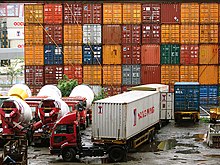
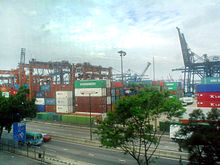
Hong Kong is one of several hub ports serving the South-East and East Asia region, and is an economic gateway to mainland China. The port is part of the Maritime Silk Road that runs from the Chinese coast via the Suez Canal to the Mediterranean, there to the Upper Adriatic region of Trieste with its rail connections to Central and Eastern Europe.[2][3][4][5]
Hong Kong set a record in its container throughput in 2007 by handling 23.9 million TEUs (20-foot equivalent units of containers), maintaining its status as the largest container port serving southern China and one of the busiest ports in the world. Some 456,000 vessels arrived in and departed from Hong Kong during the year, carrying 243 million tonnes of cargo and about 25 million passengers.
Container Port traffic
The port has been one of the busiest container ports in the world for many years, and at times the busiest. It was the
Container terminals
There are currently nine container terminals situated at Kwai Chung, Stonecutters Island and Tsing Yi (the last one completed in 2004). Substantial container throughput is handled by the River Trade Terminal at Tuen Mun and by mid-stream.
Kwai Tsing Container Terminals

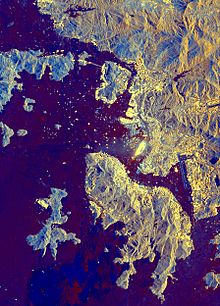
The
These terminals are operated by five companies, namely:
- Modern Terminals Ltd.(MTL)
- Hongkong International Terminals Ltd.(HIT)
- COSCO Information & Technology (H.K.) Ltd.(COSCO)
- Dubai Port International Terminals Ltd.(DPI)
- Asia Container Terminals Ltd. (ACT)
The existing 9 terminals occupy 2.17 square kilometres of land, providing 18 berths and 6,592 metres deep water frontage. These terminals handle about 60% of total container traffic handled in Hong Kong.
In July, 2020, The Port of Hong Kong welcomed HMM Gdansk, the world's largest container vessel, on its maiden call to Hong Kong at Kwai Tsing Container Terminal 7.[9]
Planning is underway for a potential Container Terminal 10 (CT10), with possible sites narrowed down to either southwest Tsing Yi or northwest
| Terminal | Operator | Depth (m) |
Berths | Quay length (m) |
Quay cranes | Area (m2) |
Capacity (kTEUs) |
|---|---|---|---|---|---|---|---|
| Terminal 1 (CT1) | MTL | 14 | 1 | 4 | |||
| Terminal 2 (CT2) | MTL | 14 | 1 | 5 | |||
| Terminal 3 (CT3) | DPI | 14 | 1 | 305 | 6 | 167,000 | >1,200 |
| Terminal 4 (CT4) | HIT | 12.5 | 3 | 8 | |||
| Terminal 5 (CT5) | MTL | 14 | 1 | 4 | |||
| Terminal 6 (CT6) | HIT | 12.5–15.5 | 3 | 11 | |||
| Terminal 7 (CT7) | HIT | 15.5 | 4 | 15 | |||
| Terminal 8 East (CT8E) | HIT/COSCO | 15.5 | 2 | 640 | 9 | 300,000 | 1,800 |
| Terminal 8 West (CT8W) | ACT | 15.5 | 2 | 740 | 8 | 285,000 | >2,000 |
| Terminal 9 North (CT9N) | HIT | 15.5 | 2 | 700 | 9 | 190,000 | >2,600 (N&S) |
| Terminal 9 South (CT9S) | MTL | 15.5 | 4 | 1,240 | 13 | 490,000 |
River Trade Terminal at Tuen Mun
The River Trade Terminal at Tuen Mun involves the consolidation of containers, break bulk and bulk cargo shipped between the Hong Kong port and ports in the Pearl River Delta. The terminal is located near
Mid-stream

Mid-stream operation involves loading and unloading containers to and from ships while at sea, with barges or dumb steel lighters performing the transfer, and then distributing or landing the containers to piers nearby. Due to high handling fees at the container terminals, Hong Kong has become the only place in the world with at-sea loading and unloading operations.
Currently, there are 11 different yard sites solely for mid-stream operations, occupying a total land area of 27.5 hectares and waterfrontage of 3,197 metres.
Ferry services
The
Government fleet
There are over 600 vessels of different types and sizes in the government fleet. About 152 vessels are major mechanised vessels serving under 16 government departments such as the
Drydocks and slipways
The port has extensive facilities for repairing, maintaining, drydocking and slipping of all types of vessels. Two floating drydocks are located off the west coast of Tsing Yi Island and two northeast of Lantau Island. The largest is capable of docking vessels up to 150,000 tonnes
Port facilities and services
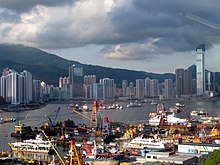
Moorings and anchorages
The Marine Department operates and maintains 58 mooring buoys for seagoing vessels. Of these 31 are suitable for ships up to 183 metres in length and 27 for ships up to 137 metres. There are 44 special typhoon mooring buoys to which ships can remain secured during typhoons. This improves efficiency and reduces operational costs of vessels through elimination of unnecessary movements. In addition to the three Immigration and Quarantine Anchorages designated for visiting vessels to complete port formalities, there are eight dangerous goods and eight general-purpose anchorages providing temporary berthing spaces for vessels.
The areas and water depths of the anchorages are diversified to accommodate different sizes and draughts of ships calling at Hong Kong. There are over 460 modern marine
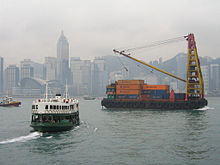
All
A comprehensive
The Hydrographic Office of the Marine Department surveys Hong Kong waters and produces nautical charts to facilitate safe navigation within the port. It functions with reference to the standards laid down by the International
Dangerous goods
Dangerous goods are moved in the waters of Hong Kong strictly in accordance with the International Maritime Dangerous Goods Code. Their movements must be recorded in Marine Department's Dangerous Goods Information System. Fire-fighting vessels operated by the Fire Services Department are kept in a state of readiness at all times. The Marine Department's pollution control vessels are on 24-hour standby to deal with
Other working facilities
To facilitate transfer of cargo between vessels and the shore, and cargo to and from
Hong Kong Shipping Register
Hong Kong is a major centre of ship ownership and management. Ships owned or managed in Hong Kong amount to 100 million gross tons. Hong Kong has been recognised by the international shipping sector as a first-rate ship registration centre, where registration of ships is entirely voluntary. At the end of 2001, 653 ships were registered in Hong Kong, with a total gross tonnage of 13.7 million tons – a 32 per cent growth over the previous year.
A Flag State Quality Control (FSQC) System was introduced in 1999
Seafarers
Hong Kong is a centre for employment of
See also
- Container transport
- Economy of Hong Kong
- List of East Asian ports
- List of harbours in Hong Kong
- Transportation in Hong Kong
References
- S2CID 225502755.
- ^ Can The New Silk Road Compete With The Maritime Silk Road?
- ^ The Maritime Silk Road in South-East Asia.
- ^ When Hong Kong was a way station on the Maritime Silk Road – new exhibition showcases recent discoveries about city’s trading past
- ^ Chung, Cien-peng (2018). What are the strategic and economic implications for South Asia of China's Maritime Silk Road initiative? The Pacific Review, 31(3), pp 315.
- ^ Hong Kong Yearbook 2007 Chapter 13 P.249. Retrieved Dec 26, 2008.
- ^ Daily Collection of Maritime Press Clippings 2005. Retrieved Oct 18, 2007. Archived 8 March 2008 at the Wayback Machine
- ^ Channel News Asia [1]
- ^ "Hong Kong welcomes world's largest container vessel". Global Cargo News. 14 July 2020. Retrieved 14 July 2020.
- ^ Hydro.gov.hk Retrieved on Oct 18, 2007.
- ^ The Hong Kong Shipping Register
- ^ Hong Kong Merchant Shipping Information Note – Quality Assurance for Hong Kong Registered Ships Archived 7 December 2010 at the Wayback Machine
External links
- Hong Kong Port Development Council
- Arrival/Departures in Hong Kong's port – Real-time
- Port and Maritime Statistics
- Asia Container Terminals Ltd
- COSCO Information & Technology (H.K.) Ltd
- Dubai Port International Ltd
- Hongkong International Terminals Ltd
- Modern Terminals Ltd
- Statistics on Vessels, Port Cargo and Containers – Census and Statistics Department
